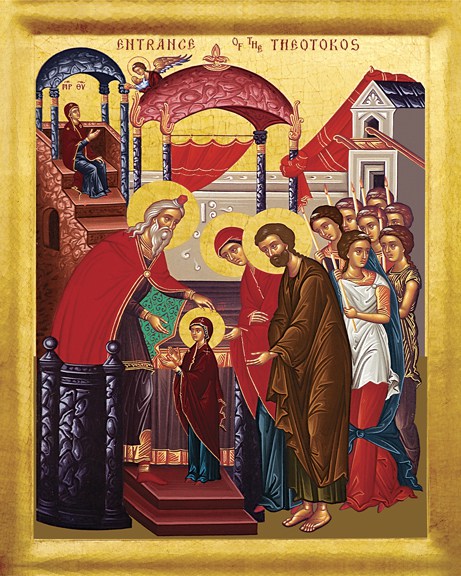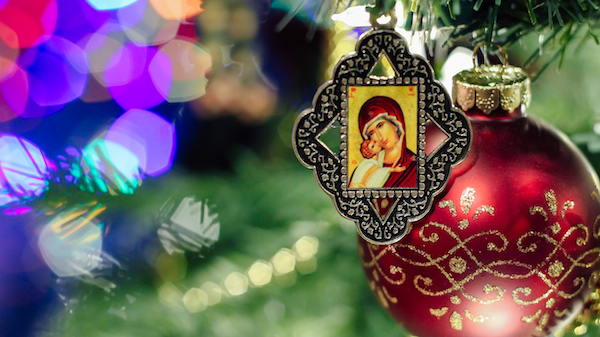Years ago I enjoyed listening to legendary radio broadcaster Paul Harvey’s weekday program The Rest of the Story. (For those of you who are old enough to remember, his distinctive voice is now playing in your head. You’re welcome.) In each show, Harvey would reveal interesting, often forgotten details about a well-known event, saving a key piece of information (usually the name of a famous person) for the surprise ending.
As we approach Christmas, the rest of the story echoes in my mind as I print out a precious ancient document to read during December.

This Friday at my house, we will box up the harvest decorations, and loved ones will help me bring up the Christmas ornaments from the basement for an afternoon of trimming the tree and decking the halls.
This year as I sit among the twinkling lights, I will spend time reading the prequel to the Nativity story throughout the month of December.
This book, influential in the Church since her early days, tells “the rest of the story” of the Virgin Mary and the birth of Jesus and is known by the unwieldy title of The Protoevangelium of James.
Not in the Bible, But Treasured in the Church
The Protoevangelium (or Protoevangelion, if you prefer Greek to Latin) functions as a prequel to the Nativity narratives in the New Testament and also overlaps them, providing more detail and filling in gaps. A helpful article in OrthodoxWiki (www.orthodoxwiki.org) summarizes the book:
The contents of this gospel describe the birth and childhood of Mary, the mother of Jesus, her coming of age and betrothal to Joseph, and the birth and early childhood of Jesus. One of the work’s high points is the Lament of Anna. A primary theme is the work and grace of God in Mary’s life, Mary’s personal purity, and her perpetual virginity before, during, and after the birth of Jesus…. Though the book is not an official part of Christian canon and hence “apocryphal,” the Gospel of James may be the earliest surviving document attesting the veneration of Mary and her continuing virginity (possible earlier ones being known only as quotes in later works).
It is no surprise that I discovered the Protoevangelium, also known as the Gospel of James or The Infancy Gospel of James, only a few years ago, even though my dual major at a Baptist university was in religion, and I attended a Protestant seminary for a year. My guess is that it was lumped in with the spurious Gnostic “gospels” that were rejected by the Church.

In the same way that secular historians accept the writings of Seneca, Juvenal, and Pliny the Younger from the first century of the “common era” (A.D.) yet attack the veracity of every fragment of the New Testament, a large number of people in the Protestant world are suspicious of every ancient Christian document except the Bible.
But the Protoevangelium, although not a part of the New Testament canon, is not a rejected text; it has been treasured by the Church throughout her history. (Most scholars agree that it was written in the early- to mid-second century.) In the Divine Liturgy of St. John Chrysostom (fourth century), during the ending prayers the priest asks that “Christ our true God” would “have mercy on us and save us” through the prayers of His holy Mother and of many saints, including “the holy and righteous ancestors of God, Joachim and Anna.” They are the Virgin Mary’s parents, and we know their names and their stories from the Protoevangelium.
On Wednesday, November 21st, the Church celebrates another event recorded in the Protoevangelium: the Feast of the Entrance of the Theotokos, commemorating the day when Joachim and Anna presented their daughter Mary, the Theotokos (“God-bearer”), to the priests at the temple in Jerusalem.
Relevance to the Church

In addition to introducing us to Joachim and Anna, the Protoevangelium also is the earliest text to give us St. Joseph’s backstory, stating explicitly that he was a widower with children at the time the young Mary was entrusted to his care. We learn in the text about the martyrdom of John the Baptist’s father Zecharias in the temple during King Herod’s slaughter of the innocents. The book is also the earliest surviving document that attests to the veneration of the Virgin Mary, her purity, and her ever-virginity.
For anyone who was taught (incorrectly and quite sloppily) that the “cult of Mary” was something that sprang up in the Middle Ages among superstitious and ignorant Roman Catholics, that last tidbit comes as a bit of a shock.
In my own evangelical background, Mary was trotted out every December, mostly in the form of a chipped statue in a crèche and the obligatory sermon about her admirable obedience and purity. She was then tucked away both physically and metaphorically with the Christmas decorations until the following December.
The Protoevangelium as Christmas Reading
Because of a religious background that ignored Mary as much as possible, I have experienced a long process of change as I learn to love her and understand her significance as the entire Church did until only a few hundred years ago. The Protoevangelium has been a part of this process.
The book is a beautiful tapestry that spends the first eight chapters on Joachim and Anna’s struggles with their infertility and the circumstances of Mary’s birth and childhood.
In chapter 9, Joseph agrees to take care of the young virgin, and the threads of the story begin to weave into the familiar events of the Nativity accounts in the Gospels of Matthew and Luke.
In the final eight chapters we read of Jesus’ birth and even find the answer to a mystery: How did the infant John the Baptist survive Herod’s horrific slaughter of all Jewish males under age two? (Answer: His mother Elizabeth hid with him in the desert.)
The story is mystical, reverent, and quite beautiful in its King James-y English translations. It is also conveniently divided into twenty-four chapters that can be read and pondered, one per day, from the first of December through Christmas Eve.

Would you like to join me in reading the Protoevangelium of James during the Nativity fast? [Click on the link to print out your own copy or read it on your device.] Spending time with this treasure is a small but significant way to hold the busyness of the season at bay while we ponder the mystery of the Incarnation. I’d like to know your thoughts, especially if this will be your first time to read it.
May God continue to bless you and your family this Thanksgiving (for Americans) and throughout the Nativity fast!
I first set foot into Orthodoxy just over a year ago (a story all its own of course), and this was the first Great Feast I encountered. Coming from the Evangelical Protestant world, you just do not hear a thing about Mary, except at Christmas, or maybe at Easter, unless it is some polemical dig at “Catholic Mary Worship”. But there were 2 questions I never heard any preacher ever even think to ask: First, “Why was Mary so special to begin with?” Second, “How could a mortal woman’s womb contain the uncontainable God?”I suppose there was some bias stemming from Sola Scriptura (Luke has the most to say about Mary, but it’s not much), but much of the rest seemed to be just a reflexive anti-Catholicism.
Being asked the second question especially began to really put The Most Holy Theotokos into perspective, and I find new depths of understanding every time I read and recite through St. Romanus’s Akathist. The Protoevangelium too has been a wonderful find.
I love your line about “a chipped statue in a crèche”. Since finding Orthodoxy, I’ve tried mightily to make sure I don’t let that happen.
Thanks for your comment, Skip, and for mentioning the Akathist of St. Romanos. I wasn’t aware of it, and I just printed out a copy from Kh. Frederica Mathewes-Green’s site. If anyone else is interested, you can find it here: http://frederica.com/writings/the-akathist-annunciation-hymn-of-st-romanos.html.
Thank you for the explanation and the link. I will read along with you.
I have read the Protoevangelium of James just once since I became Orthodox almost three years ago. I appreciate your post and will join you in reading it again during the Nativity fast.
Thank you for reminding me of this! My husband and I discovered the protoevangelion of James in our church fathers volumes when we were becoming open minded Protestants, but I have not read it in its entirety or since becoming orthodox. I accept your challenge!
Thank you, my fellow Protoevangelium readers. Holy Theotokos, pray for us during this Nativity season!
Thank you, Lynette, for bringing this ancient treasure to our attention and at a perfect time to read it. My grandchildren are marking the 40 days of Advent with the lovely Jesse tree ornaments and Bible readings put together by Elissa Bjeletich. They love the Nativity story and ask questions about Mary the Theotokos, Joseph, and the Baby Jesus, and His grandparents . Thankfully in our Orthodox tradition we have these stories for them. I will gladly download the copy of the Protoevangelium of James and read along with you this Advent season.
Wonderful! I am so excited about what Elissa is doing for Advent. Also, Nicole Roccas over at Time Eternal has a suggested Advent reading–I think it’s St. Athanasius’s “On the Incarnation,” but she’s also recommending Alexander Elchaninov’s Diary of a Russian Priest. So many riches are available to us during this Nativity fast?
The Protoevangelium is a complete ‘heart’ treasure . I ‘ found ‘ it after this last 2020 Christmas (Anglican on a journey) during lockdown here in the UK. It’s a forever ‘ re read ‘.
Yes, it is!